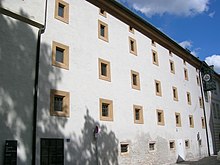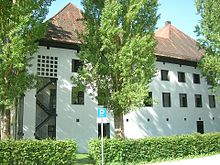Karljosef Schattner
Karljosef Schattner (born August 24, 1924 in Gommern ; † April 10, 2012 in Eichstätt ) was a German architect . As head of the diocesan and, from 1972, of the university building department in Eichstätt, he shaped the image of the city for over three decades with its renovations and additions to existing buildings, "determined by the clear and sensitive harmony between old and new", and thus set standards of architecture.
Life
Karljosef Schattner attended secondary school in Magdeburg from 1934 to 1942 . Drafted into the military in 1942, he returned from the Baltic States in 1945 with a life-threatening wound and was initially interned in the US prisoner of war in the Ingolstadt military hospital . From 1946 to 1949 he completed a commercial apprenticeship in Gommern and married Irmingard Ried after moving to Eichstätt. In 1949 he began to study architecture at the TH Munich with Hans Döllgast , Martin Elsaesser , Franz Hart , Friedrich Krauss and Georg Werner. After graduating in 1953, he worked for Franz Hart in the Munich architecture firm. In 1955 and 1956 Schattner worked for the Ingolstadt architect Josef Elfinger , with whom he later built the college building of the Catholic University of Eichstätt and the Maria Ward student home in Eichstätt.
In 1957 he took over the management of the Diocesan Building Office in Eichstätt and from 1972 onwards also the management of the University Building Office of the Catholic University of Eichstätt. In 1991 he retired and the Eichstatt-born architect and Karl Frey took over the office.
The work of Carlo Scarpa , which he first presented in 1981 in the architecture magazine Baumeister , shaped his attitude as an architect . The additive joining of the new to the existing old, implemented entirely in the spirit of Scarpa, the tense contrast between Schattner's emphatically modern architectural language and the existing building fabric formulate the design model for many of his works.
For the new building of the university library he got Günter Behnisch , which he had built from 1980 to 1987.
Karljosef Schattner was an honorary professor at the TU Darmstadt from 1985 to 1994 and a visiting professor at the ETH Zurich from 1989 to 1991 .
In 2007 he donated 800 books to the university library of the Bauhaus University Weimar . These include important architecture monographs such as "Louis I. Kahn - Complete Works 1934–1974" and "Ticino Architects - Buildings and Designs 1960–1985."
Many of his buildings were photographed by the architecture photographer Klaus Kinold , who works internationally and is a friend .
Schattner died in Eichstätt in 2012 at the age of 87. Schattner made the city a center of attraction for modern architecture.
Understanding of architecture
I believe that the dialogue between today and yesterday is necessary and that a confrontation must take place between the two. Adaptation and imitation, however skilfully packaged, will devalue existing historical architecture. We cannot avoid solving our tasks with our means, our constructions limited by the horizon of our time.
We will learn that the proximity of modern architecture enables new stimuli for perceiving and recognizing previously unknown properties of historical architecture. Architecture solved and always solves the same problems: asserting material and its structure. Apply rhythm, symmetry and asymmetry. Exploiting light and shadow. The tectonics of architectural masses, their scale and the mutual proportionality use of its components.
It is precisely the diversity and diversity of historical architecture that demands that we respond to it with imagination and joy. We have to approach the historical structures with our wishes and bring them to life. The value that originates from historical architecture lies in the variety of details, lies in the quality of the same.
It is interesting to see how different seemingly identical elements are. This differentiation is what makes historical cities so attractive. This creates an individuality that does not deny an overarching commitment. All of this arose out of a mindset and was never camouflage. I think that even today it must be possible to solve the problems, but not through camouflage and not through a misunderstood individualism, which is basically egoism.
Works
Buildings in Eichstätt
- 1959–1961: Maria Ward dormitory with Josef Elfinger
- 1960–1965, 1979–1980: College building of the Catholic University with Josef Elfinger
- 1963–1964: New building of the state and seminar library of the Catholic University of Eichstätt (KU)
- 1963–1965: Catholic Church of the Holy Family
- 1965–1966: Conversion of the former cathedral deanery into an episcopal ordinariate
- 1970–1974: Conversion of the former summer residence of the prince-bishop into an administrative building of the KU
- 1973–1976: Jura Museum, Willibaldsburg
- 1975: Cathedral decanting office
- 1977–1982: Expansion of the diocesan museum
- 1978–1980: Reconstruction of the Ulmer Hof (previously grammar school) for the Catholic theology department (the former courtyard was roofed over and expanded to become the theology department library of the KU) with Jörg Homeier
- 1979–1981: Student Center - Catholic University Community
- 1981–1984: Conversion and new building of the episcopal seminary
- 1983: Residence of the provost of the cathedral
- 1985: Extension to the diocesan archive
- 1985–1987: Institute for Journalism at the KU
- 1985–1988: Conversion of the former orphanage (18th century) for the departments of psychology and journalism at the KU
- 1985–1988: KU cafeteria
- 1985: Extension to the diocesan archive
- 1996: Conversion of an old people's home into a nursing home
Other buildings
- 1968–1970: Parish Church of St. Martin, Etzelwang
- 1969–1972: staff building, Pfünz
- 1971 and 1972–1974: New building and reconstruction of the Catholic parish church, Adelschlag
- 1987–1992: Extension at Hirschberg Castle , Beilngries with Karl-Heinz Schmitz
- 1994–1996: Wallmeisterhaus, Ulm on the Danube with Wilhelm Huber and Dieter Kienast
- 2009: Preliminary draft for the House of Bishops in Limburg an der Lahn
Awards, prizes and honors
- 1981: BDA Prize Bavaria for administration building, Eichstätt
- 1981: Concrete architecture prize
- 1982: Medal for special services to monument protection from the Bavarian Ministry of Culture
- 1983: BDA Prize Bavaria for the renovation of the Ulmer Hof , Eichstätt
- 1986: Heinrich Tessenow Medal
- 1988: German Critics' Prize in the Architecture category
- 1990: Great Architecture Prize from the Association of German Architects
- 1994: Art and Culture Prize of the German Catholics
- 1996: Honorary Fellow of the Royal Incorporation of Architects, Scotland
- 1997: Federal Cross of Merit on ribbon of the Order of Merit of the Federal Republic of Germany
- 1998: Honorary Senator of the Catholic University, Eichstätt
- 2004: Ordo Sancti Silvestri Papae (Knight of the Papal Order of Holy New Year)
- 2008: Honorary citizen of the city of Eichstätt
- 2009: Leo von Klenze Medal
Quotes
- "To deny the present would be to deny history."
Schattner employee in the Eichstätt Diocesan Building Office
- 1960–1988: Andreas Fürsich
- 1977–1988: Jörg Homeier
- 1982–1988: Norbert Diezinger
- 1959–1989: Anton Nitsch
- 1985–1989: Wilhelm Huber
- 1961–1991: Hans Polak
- 1987–1992: Karl-Heinz Schmitz
Exhibitions
- 1980: Antwerp
- 1983: Berlin IDZ
- 1984: Augsburg armory
- 1986 University of Cologne , Technical University of Eindhoven
- 1986: Seville
- 1989: Buildings and projects - Architekturforum Zürich
- 1990: École polytechnique fédérale de Lausanne
- 1991: Bruges Museum of Architecture
- 1993: University of Karlsruhe
- 1994: Saxon State Parliament Dresden
- 1994: L'ordre des Architectes et des Ingénieurs-Conseils
literature
- Ulrich Weisner: New architecture in detail. Heinz Bienefeld , Gottfried Böhm, Karljosef Schattner. Kerber Verlag, Bielefeld 1989, ISBN 3-924-63909-4 , exhibition catalog.
- Wolfgang Pehnt : Karljosef Schattner. An architect from Eichstätt. Hatje, Stuttgart 1988. New edition 1999, ISBN 3-7757-0818-9
- Karljosef Schattner, architect. A guide to his buildings. Architecture Museum of the Technical University of Munich 1998, 12 pp.
- Frank Dengler: Building in a historical setting. The architects Dieter Oesterlen , Gottfried Böhm and Karljosef Schattner. Olms, Hildesheim u. a. 2001, ISBN 3-487-11882-3 , dissertation from the University of Bochum .
- Karljosef Schattner and Klaus Kinold : Architecture and Photography - Correspondence. Birkhäuser, Basel a. a. 2003, ISBN 3-7643-6934-5 .
- Nicolette Baumeister: Building Culture Guide 26 - Youth Center, Pfünz Castle. Koch, Schmidt u. Wilhelm 2006, ISBN 978-3936721768 .
Movie
- New architecture in the old palace. Documentary, Germany, 1984, 43 min., Script and director: Dieter Wieland , camera: Hermann Reichmann, production: Bayerischer Rundfunk , series: topography, table of contents and online video from BR.
Web links
- Literature by and about Karljosef Schattner in the catalog of the German National Library
- Karljosef Schattner. In: arch INFORM .
- Schattner on architecture , ku.de.
Individual evidence
- ^ A b Dieter Bartetzko : On the death of the architect Karljosef Schattner: Buildings out of joy and fantasy. In: FAZ , April 12, 2012, page 28.
- ↑ The art of separating and connecting. For the 75th birthday of Karljosef Schattner. In: BauNetz , August 24, 1999.
- ^ Karljosef Schattner: Scarpa as a role model and inspiration. In: Baumeister , Callwey, Munich 1981, issue 10, p. 990ff.
- ↑ -tze: The Scarpa from Eichstätt. On the death of the architect Karljosef Schattner. In: BauNetz , April 12, 2012.
- ↑ Bavarian architect gives away 800 books. In: BauNetz , June 8, 2007.
- ↑ Modern architecture in Eichstätt. Retrieved July 26, 2020 .
- ↑ a b c d Schattner on architecture. In: KU Eichstätt .
- ↑ Catalog raisonné 1960-1982. Retrieved July 18, 2020 .
- ↑ Diözesanbauamt Eichstätt: The most important projects 1957–1992
- ↑ Conversion of the Ulmer Hof into a department building for Catholic Theology, Eichstätt. Association of German Architects, accessed on July 25, 2020 .
- ↑ Klenze Medal for Schattner. In: Eichstätter Kurier , June 26, 2009.
- ^ Diocesan master builder Karljosef Schattner - Eichstätt. Retrieved August 8, 2020 .
- ↑ Catalog raisonné. July 19, 2020, accessed on July 19, 2020 (German).
- ↑ Norbert Diezinger. In: archinform. July 19, 2020, accessed July 19, 2020 .
- ↑ office. June 16, 2017, accessed on July 19, 2020 .
- ↑ schmitzarchitekt. Retrieved July 19, 2020 .
| personal data | |
|---|---|
| SURNAME | Schattner, Karljosef |
| ALTERNATIVE NAMES | Schattner, Karl Joseph |
| BRIEF DESCRIPTION | German architect |
| DATE OF BIRTH | August 24, 1924 |
| PLACE OF BIRTH | Gommern |
| DATE OF DEATH | April 10, 2012 |
| Place of death | Eichstatt |








